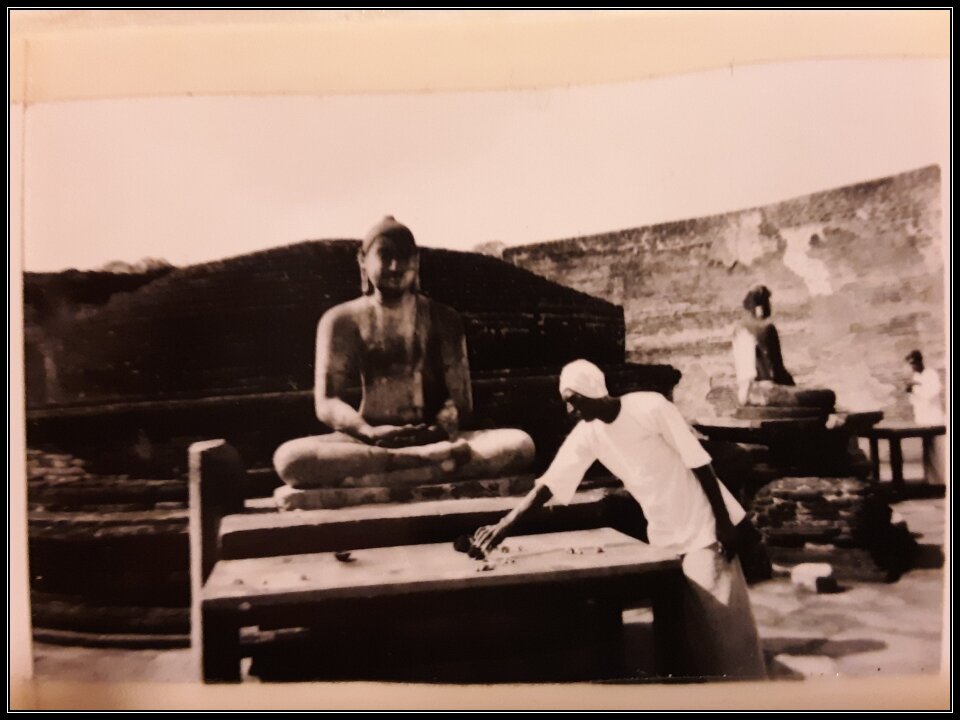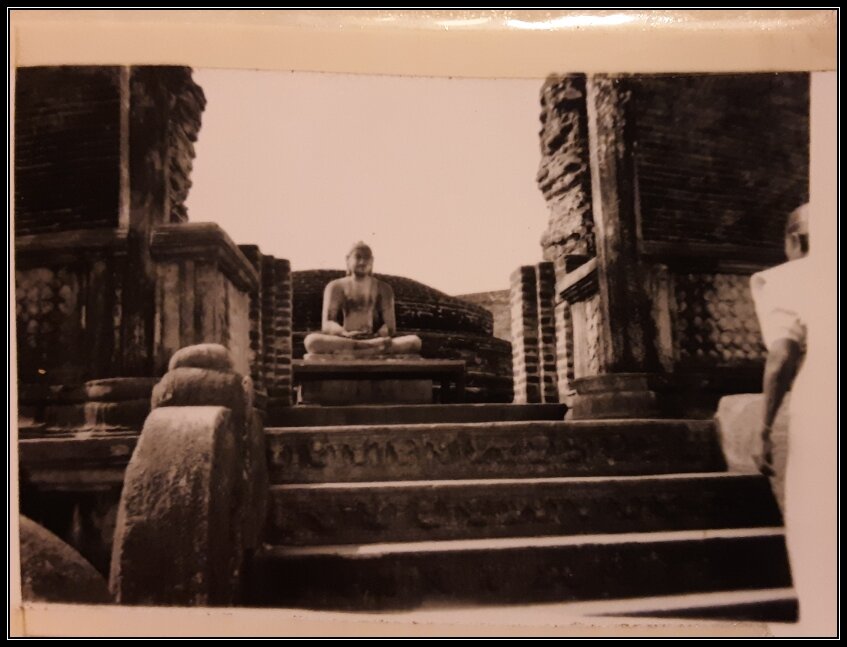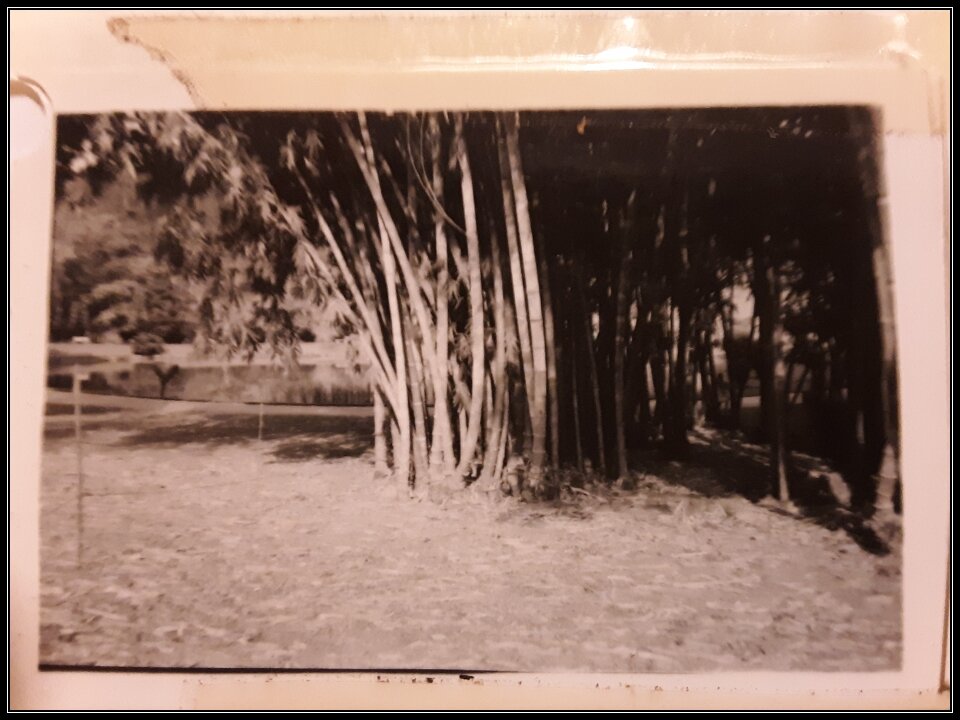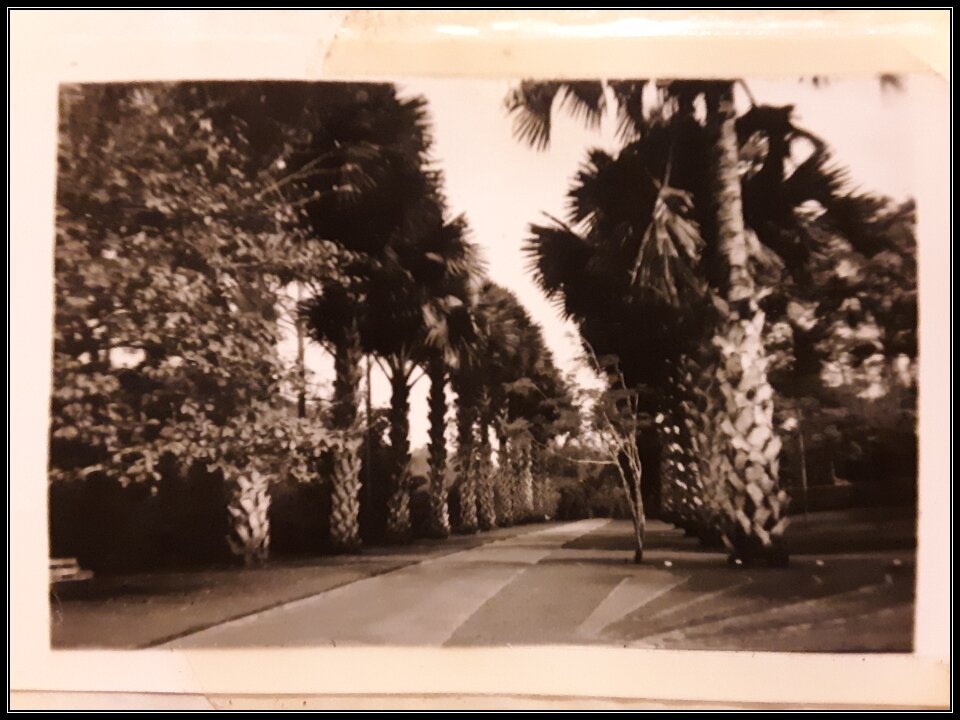The Big Trip-part 11
The next day was Saturday, our one week anniversary. We visited some old ruins which they say date back to 600 b.c. - old temples and pillars and Buddha statues.
Next stop - Sigeria for lunch. The size of Sigeria rock you can see here by comparison to the car on the road.
Hundreds of years ago someone built a temple on the top and they climbed it by making a little niches in the sheer sides of the huge rock. Now they have built stairs and railings most of the way up. Alan, Barb and I set out to climb it. Halfway up is a grassy resting place where they have put up a wire cage for the safety of tourists who are attacked by rock bees. At one spot along the way you can see the remains of ancient frescoes. After the grassy place you are on your own, and you use the old niches for stairs with only an iron rod railing to hold on to. I went all the way up and at the top there were workmen repairing part of the temple, It was lunch time and at a signal they all lit down the side of the rock, practically at a run, and yelling at the top of their lungs. I was afraid they’d wake up the rock bees. They hardly touched the hand rail; I went inching and crawling down after them, hanging on for dear life and wondering how the ancients ever did it with nothing out there between them and disaster.
The guest house there was another Princess Elizabeth remodeling job. They served us delicious banana fritters for lunch.
Mannie took a picture of this tree growing over a rock.
Then we drove through the thickest plantation area: Rubber, coconut, pineapple, cocoa, pepper vines growing on cottonwood trees, rice patties; at one stop we took these snaps of the people coming down the road with buckets of rubber milk on their heads. And the first picture is a rubber tree area- It certainly doesn’t do it justice.
We kept stopping, just because it was so beautiful and we didn’t want to let it pass so quickly. At one spot this man and child came by. We were looking at the disappearing plants in the roadside and he stopped to watch us touching the leaves to see them fold up. His gaily colored lungee is also folded up for walking.
We call this one, “indiginee and child”. We thought it smarter to use the word, indigenous, rather than native and we kept shopping for indigenous fabrics.
We kept passing Buddhist monks in their bright yellow-orange robes and shaved heads, and the funny looking covered wagon Ceylonese carts with their gaily painted wheels and colored fringes, and we would say, “We must get pictures of them,” and someone else would say, “We’ll see some more later on.” So none of us ever got those pictures.
As we drove into Kandy we saw our first tea plantations. Kandy is the most famous hill station of Ceylon. An American film company had just been there for several weeks making a picture called “Elephant Walk” and I think the local merchants and the hotel though we were remains of the troupe. Barb and I, for instance, had a luxurious big room, but it was Rs. 60/-per day for room and board (that’s $6.00 each) - and we had paid an average of Rs. 10/- in the guest houses.
It was raining a little, but we walked through the town shopping, along the lake edge, and up to the Temple of the Tooth, the biggest Buddhist temple in the Near East. It is called the Temple of the Tooth because they have encased in a shrine inside what is supposed to be one of Buddha’s teeth. It is said that it resembles more an alligator’s tooth than a man’s. They also have some of Buddha’s bones. We went inside and they were just starting services. Two men stand on each side of the door as you enter the main part of the temple, beating gongs and shrilling flutes. In the middle of the big hall is a small shrine which we could not enter, but we could stand at the door and watch the people going in with their flowers and offerings to kneel before the seated figure of Buddha and go through their rituals of touching their foreheads to the ground. There is no light in the room except from the doorway where we stood watching, and since the shrine itself is in the big main hall which is also dimly lighted, it gave the occasion a very eerie, mysterious East flavor, especially when the monks would wander around with their waving pots of burning, smoking incense and the wavering yellow lights of the flames would wash over the silent Buddha, the prostrate devotees and the shaved heads of the bearer.
A guide took us into the office rooms of the temple where they keep the sacred books, some of them dating back before Christ, written on aged yellow parchment scrolls. We signed the guest book and saw the signatures of G. B. Shaw, President Wilson, King George V. and many other famous names. Then we went upstairs where the crowd was waiting to go into another shrine of some sort. They all had flowers and fruit and things for offerings. It seemed that only a few people could go in at a time and we got tired of waiting, so we never found out what goes on up there.
This is a picture Mannie took of Kandy from the hill across the lake. In the lake is a little square pavilion which is covered with colored lights at night and a fountain plays in color.
On Sunday we went out to see the botanical gardens. To quote the log: orchids - spices - palm avenues - bamboo clumps - snake vines - fly catcher plant - hedge houses - propeller pods. Here are Mannie’s pictures.
This was a particularly pretty bamboo clump near a little lake.
A native boy was raking leaves.
Tallest straightest palms I have ever seen. See Barbara and Alan standing there.
Another type of palm avenue. Notice the fan looking thing on the grass. That is a sample of different types of grass. The gardens are beautifully kept. Have every plant and tree imaginable.
and this is looking up.
We left the hotel after lunch and on our way out of Kandy we stopped at the top of the hill to look back at the town (from which vantage point Mannie took the earlier picture) and along came this line of children on their way to school. They were the children of the Kandian chiefs, said our driver. A bull-drawn cart just about got in one picture.
And we stopped once more to watch the elephants bathing.
We left Kandy and went back down to Colombo, where we stayed at the Galle Face Hotel. We didn’t like the hotel. No landscaping; and though it was on the ocean, no beach. Too expensive - the boy’s room had no bathroom. Yet it is “the” hotel of Colombo. At dinner that night we decided we’d go back out to Mt. Lavinia to spend our last day and night. A U.S. ship was in port and a group of sailors came into the dining room. It is a very ritzy looking place, actually, and as they passed our table we heard one boy drawl in an argumentative tone, “I just don’t b’long hyear.” Our sentiments exactly; not because it was ritzy, but because we wanted to spend our vacation in the beauty spots.
So the next morning we finished our Ceylon shopping, arranged to have all the stuff we had bought shipped to Delhi through the Embassy and then took the local train to Mt. Lavinia in time for a rainy tea on the verandah with some other Delhi folks who were there. And the next morning after that we had another early swim and stayed out too long in the sun. We had to separate from Barbara there because she had no more leave time accumulated, and Mannie, Alan and I took the train out that night. We traveled all night and we only had cheap sheets which we had picked up in Colombo, so we were all pretty uncomfortable. The compartments are only double ones so Alan and I took one and Mannie was next door with Mr. Rao. We arrived at the port Tolaimanar at 5:00 in the morning, went through customs without a hinge and boarded a ferry boat called “Gochen”. The journey across the channel between Ceylon and India takes several hours, and we were all so tired still that we flaked out on the benches and slept the whole way with our heads resting on life jackets. At the other side we immediately knew we were in India.
Ceylon had been an entirely different experience from India. The people are much more prosperous, they grow coconuts and tea and bananas, and their whole standard of living is better. The little villages we went through were cleaner, they all had big health enters and hospitals and dispensaries. The roads were well kept and free from the horrible bullock-cart traffic you get in India. The servants and waiters were more human, not so obsequious, they had more self pride. There were no beggars, and we didn’t see any “road-side worshippers” as we call the men you see constantly squatting along the roads any where you might go in India. It’s a garden paradise.
But the minute we set foot off the boat in India we were besieged by beggars. We had to go through customs again and we had to laugh when policeman inside the door directed me toward the “ladies search room.” I went inside and there stood a timid little Indian woman who came about to my waist and she looked up at me with her limpid big eyes and said in a small voice, “Have you anything to declare.” I said “no” and she looked relieved and waved me out.
The dock there is way out on a sand bar and the village seemed to be just full of beggars and children. Not a tree or shrub or bit of green anywhere except for the green slime on the shallow backwashes on the sand. We had to sit there in the blazing sun for hours so we went down to the dining car of the train which was out over the water a ways and ordered breakfast. Little boys came along side the train window and begged to dive for coins, so I threw them a few. We finally established ourselves in a crowded first class coach with about six Indians in a car which should have sat six all together. Beggars swarmed around our windows and we tried to ignore them. One Indian man across from us kept taking small coins out of his dhoti and giving them away, but we refused to be moved. We could not help but watch the little boys who sang a sort of chant as they beat on their little bare chest to a rhythm caused by swinging their bodies in a twist from side to side and letting their arms swing loose and their doubled fists flop up and hit their chests as they swing.
We had a long, hot, dirty ride and arrived at Madurai in the late afternoon. We stayed at the Railroad Hotel in rooms above the station. We were too tired to do anything but take a short walk and go to bed, dog tired.
The next day we went to the big temple there, one of the most magnificent in all India. These are Mannie’s pictures.
The first one is a beggar, taken from our train window.
We spent a good two hours wandering though this temple. It is all built around the big tank, where you see the steps.
The black blob in the lower right is me standing by a pillar.
He has a good shot of one of the statues. Most of the stone carving work is inside the different halls where there is no light or where cameras aren’t allowed. We even had to wait until a certain time to take pictures here. There is one huge hall somewhere in the maze of the temple that has 100 big stone pillars, highly carved - nothing else except a very small shrine of Shia, and a colony of bats hanging overhead. It is dark and musty and we had to walk through the whole temple barefooted.
This old fellow was covered with ashes. He looked very ghostly and he followed us all over the court before we entered the temple buildings. He is a saint of some sort. He wanted us to give him some money. Mannie told him, “We never give money to saints.”
At one place in the temple I watched a man for about five minutes. He was sitting in a trance with his legs folded in his lap, Yogi style. He didn’t once move a muscle. He could just as well have been one of the stone statues around him. Groups of people would pass us ringing gongs, swinging incense and chanting. They were doing their pujas on a trip through all the temple. Some of the halls are all decorated with paintings on the walls and ceilings; others were very severe and sombre and practically empty, others are filled with carved pillars and big stone images and wall carvings of the various Hindu gods. After awhile it begins to be too much to bear, your imagination overflows, you think you’ve seen everything in temple adornment and still it goes on, room after room. At one place in the temple where there is no roof, shopkeepers have set up their stalls between the carved pillars, and there is row after row of tailors, fruit vendors, shoe makers, cloth merchants, et al. One small boy followed us into the temple and never left us through the whole trip, about three hours.
We left Madurai that afternoon about 4:00 via plane to Trivandrum, over on the west coast and were happy to see the green tropical verdure of the coast again. At the airport I recognized our USIS Librarian, Joe Sakey and when I spoke to him he offered to take us to our hotel. He and our Bangalore librarian who was in town on vacation, Betty Winn, had come to meet Mary Langford, a WHO (World Health Organization) worker, who was just joining Betty for a few days vacation. So we all joined forces and Joe took us that afternoon out to a lovely beach for a swim. It did India proud. It was as nice as any beach we had found in Ceylon. We met the Maharaja of Travancore and his family there and they let us use their bathing house to change clothes. One of the natives took us on his log boat for a paddle on the swells out past the point of the cove into the wide open sea and while we were out it began to rain hard cold drops on our backs and we splashed ocean water on each other to keep warm. When we got back to the beach another native was waiting with coconuts and a hatchet. Flick, flick, flick, and he had made a neat little hole in the end of a coconut and we drank nature’s nectar from nature’s cup.
Back at the hotel we met Dr. Manshardt who was on tour from Delhi USIS and Bill Rutter, our ex-Publications Officer who quit the State Department to work in India for New American Library. So we had a big banquet table full of people for dinner.
The next day the two librarians and we three hired a taxi to take us down to Cape Comorin, the southernmost point of India. On the way we stopped to see an old wooden palace of the Hysala dynasty - red tile roofs -clean and well kept - swinging beds - women’s purdah room in gables - man’s torture cage - acres of rooms, says our log. It can’t mean much to you, but to me it brings up a whole reel of images. Mannie took these pictures. They are all taken from various windows in the palace. The silhouettes in No. 1 are Me, Alan and Mary.
We stopped again at a little rest house to eat the lunch we had packed, and Alan had no more than sat down than his arms were covered with white welts from bug bites. If a bug that bites gets within a mile of Alan it will find him.
































